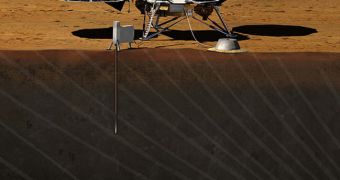Officials at the American space agency say that NASA has decided to tap Centennial, Colorado-based United Launch Services LLC for providing the delivery system needed to launch a new lander towards Mars about three years from now.
According to the announcement, the Interior Exploration Using Seismic Investigations, Geodesy and Heat Transport (InSight) mission will launch for Mars in March 2016, aboard an Atlas V rocket flying in the popular 401 configuration.
Takeoff is currently planned to occur from Space Launch Complex 3E (SLC-3E) at the United States Air Force's (USAF) Vandenberg Air Force Station, in California. NASA says that the total mission costs will be somewhere around $160 million (€ 116.15 million).
This will include everything from launch support requirements, tracking, data transfers and telemetry to spacecraft design, construction processing and payload integration. InSight will spend at least 2 years investigating the surface of Mars
At this point, a landing site has not been selected for the mission. NASA is using its Mars Reconnaissance Orbiter (MRO) to investigate a total of 4 potential candidates, the most promising sites out of an original batch of 22. All of them are located in a place called Elysium Planitia.
There are several conditions that prospective landing sites need to meet, including closeness to the Equator, low elevation, flat surfaces, limited amounts of rocks, and a soil soft enough to allow for InSight's heat flow probe to penetrate deep underground.
The main scientific mission for this lander will be to investigate the complex and mysterious processes that led to the formation of the rocky inner planets in our solar system more than 4 billion years ago. The data it collects can potentially be used to understand Mercury, Venus, Earth and Mars even better.
InSight will carry the Seismic Experiment for Interior Structure (SEIS), which is provided by the French Space Agency (CNES). SEIS is a sensitive broadband seismometer designed to investigate potential seismic or interior activity on Mars.
The Heat Flow and Physical Properties Package (HP3) instrument is a heat flow probe provided by the German Space Agency (DLR). A tether attached to this tool contains temperature sensors every 30 centimeters (11.8 inches) for accurate Martian interior temperature readings.
The third instrument is the Rotation and Interior Structure Experiment (RISE), which will provide precise measurements of the planet's rotation by using signals from the radio communications array on InSight.
This lander is very similar to, and heavily inspired by, the 2008 NASA Phoenix Mars Lander mission.

 14 DAY TRIAL //
14 DAY TRIAL //